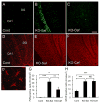Modulation of astrocyte glutamate transporters decreases seizures in a mouse model of Tuberous Sclerosis Complex
- PMID: 20045054
- PMCID: PMC2823985
- DOI: 10.1016/j.nbd.2009.12.020
Modulation of astrocyte glutamate transporters decreases seizures in a mouse model of Tuberous Sclerosis Complex
Abstract
Astrocyte dysfunction may contribute to epileptogenesis and other neurological deficits in Tuberous Sclerosis Complex (TSC). In particular, decreased expression and function of astrocyte glutamate transporters have been implicated in causing elevated extracellular glutamate levels, neuronal death, and epilepsy in a mouse model of TSC (Tsc1(GFAP)CKO mice), involving inactivation of the Tsc1 gene primarily in astrocytes. Here, we tested whether pharmacological induction of astrocyte glutamate transporter expression can prevent the neurological phenotype of Tsc1(GFAP)CKO mice. Early treatment with ceftriaxone prior to the onset of epilepsy increased expression of astrocyte glutamate transporters, decreased extracellular glutamate levels, neuronal death, and seizure frequency, and improved survival in Tsc1(GFAP)CKO mice. In contrast, late treatment with ceftriaxone after onset of epilepsy increased glutamate transporter expression, but had no effect on seizures. These results indicate that astrocyte glutamate transporters contribute to epileptogenesis in Tsc1(GFAP)CKO mice and suggest novel therapeutic strategies for epilepsy in TSC directed at astrocytes.
2009 Elsevier Inc. All rights reserved.
Figures





Similar articles
-
Microglial activation during epileptogenesis in a mouse model of tuberous sclerosis complex.Epilepsia. 2016 Aug;57(8):1317-25. doi: 10.1111/epi.13429. Epub 2016 Jun 6. Epilepsia. 2016. PMID: 27263494 Free PMC article.
-
Epileptogenesis and reduced inward rectifier potassium current in tuberous sclerosis complex-1-deficient astrocytes.Epilepsia. 2005 Dec;46(12):1871-80. doi: 10.1111/j.1528-1167.2005.00289.x. Epilepsia. 2005. PMID: 16393152
-
Tsc2 gene inactivation causes a more severe epilepsy phenotype than Tsc1 inactivation in a mouse model of tuberous sclerosis complex.Hum Mol Genet. 2011 Feb 1;20(3):445-54. doi: 10.1093/hmg/ddq491. Epub 2010 Nov 9. Hum Mol Genet. 2011. PMID: 21062901 Free PMC article.
-
A circuitry and biochemical basis for tuberous sclerosis symptoms: from epilepsy to neurocognitive deficits.Int J Dev Neurosci. 2013 Nov;31(7):667-78. doi: 10.1016/j.ijdevneu.2013.02.008. Epub 2013 Feb 26. Int J Dev Neurosci. 2013. PMID: 23485365 Free PMC article. Review.
-
Tuberous sclerosis and epilepsy: role of astrocytes.Glia. 2012 Aug;60(8):1244-50. doi: 10.1002/glia.22326. Epub 2012 Mar 21. Glia. 2012. PMID: 22438024 Review.
Cited by
-
Specific Features of Focal Cortical Dysplasia in Tuberous Sclerosis Complex.Curr Issues Mol Biol. 2023 May 3;45(5):3977-3996. doi: 10.3390/cimb45050254. Curr Issues Mol Biol. 2023. PMID: 37232723 Free PMC article. Review.
-
Homeostasis of the Intraparenchymal-Blood Glutamate Concentration Gradient: Maintenance, Imbalance, and Regulation.Front Mol Neurosci. 2017 Dec 5;10:400. doi: 10.3389/fnmol.2017.00400. eCollection 2017. Front Mol Neurosci. 2017. PMID: 29259540 Free PMC article. Review.
-
Impact of GABA and nutritional supplements on neurochemical biomarkers in autism: a PPA rodent model study.Front Mol Neurosci. 2025 Mar 18;18:1553438. doi: 10.3389/fnmol.2025.1553438. eCollection 2025. Front Mol Neurosci. 2025. PMID: 40171233 Free PMC article.
-
Astrocytes as Guardians of Neuronal Excitability: Mechanisms Underlying Epileptogenesis.Front Neurol. 2020 Nov 26;11:591690. doi: 10.3389/fneur.2020.591690. eCollection 2020. Front Neurol. 2020. PMID: 33324329 Free PMC article. Review.
-
Rapamycin for treating Tuberous sclerosis and Autism spectrum disorders.Trends Mol Med. 2011 Feb;17(2):78-87. doi: 10.1016/j.molmed.2010.10.002. Epub 2010 Nov 4. Trends Mol Med. 2011. PMID: 21115397 Free PMC article. Review.
References
-
- Akbar MT, Rattray M, Williams RJ, Chong NW, Meldrum BS. Reduction of GABA and glutamate transporter messenger RNAs in the severe-seizure genetically epilepsy-prone rat. Neurosci. 1998;85:1235–1251. - PubMed
-
- Chu K, Lee ST, Sinn DI, Ko SY, Kim EH, Kim JM, Kim SJ, Park DK, Jung KH, Song EC, Lee SK, Kim M, Roh JK. Pharmacological induction of ischemic tolerance by glutamate transporter-1 (EAAT2) upregulation. Stroke. 2007;38:177–82. - PubMed
-
- Cirrito JR, May PC, O'Dell MA, Taylor JW, Parsadanian M, Cramer JW, Audia JE, Nissen JS, Bales KR, Paul SM, DeMattos RB, Holtzman DM. In vivo assessment of brain interstitial fluid with microdialysis reveals plaque-associated changes in amyloid-β metabolism and half-life. J Neurosci. 2003;23:8844–8853. - PMC - PubMed
Publication types
MeSH terms
Substances
Grants and funding
LinkOut - more resources
Full Text Sources
Medical
Molecular Biology Databases
Miscellaneous

